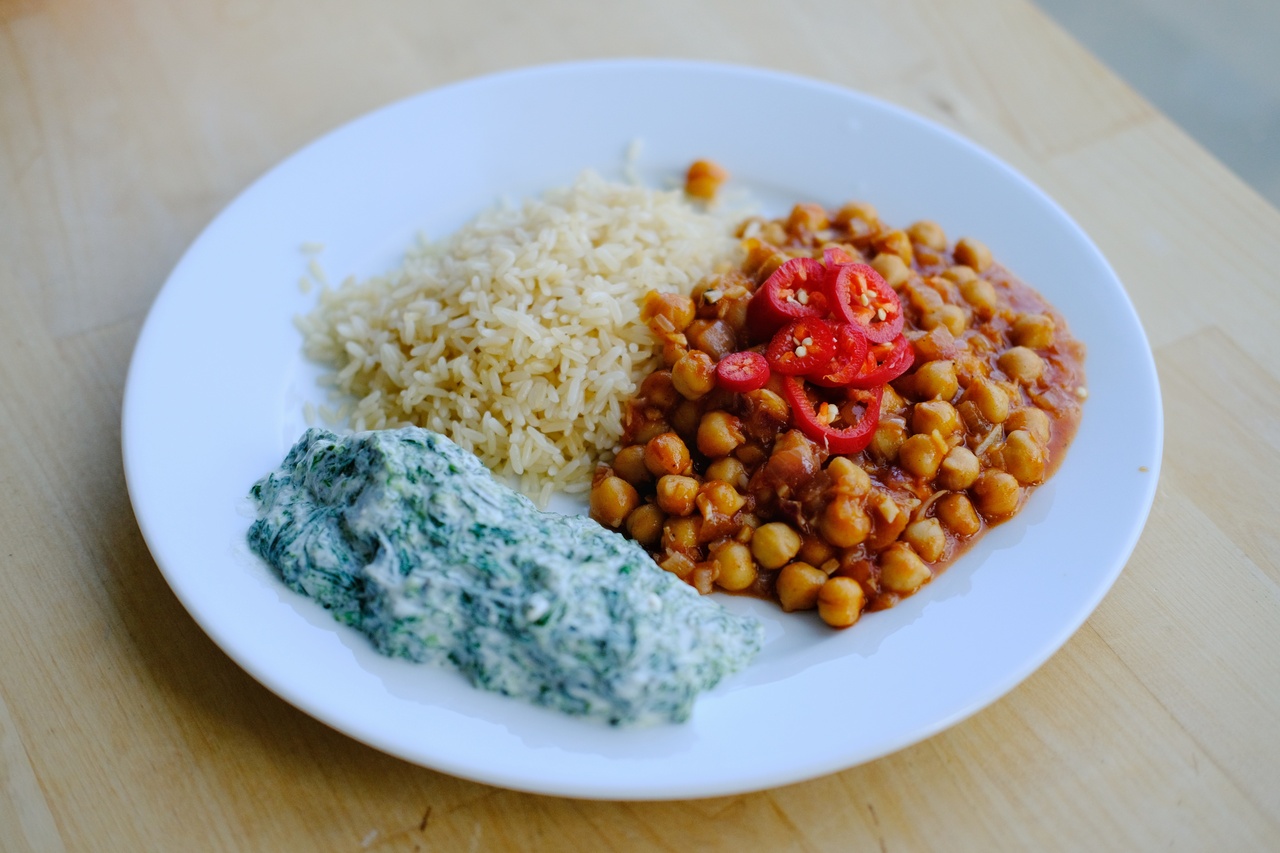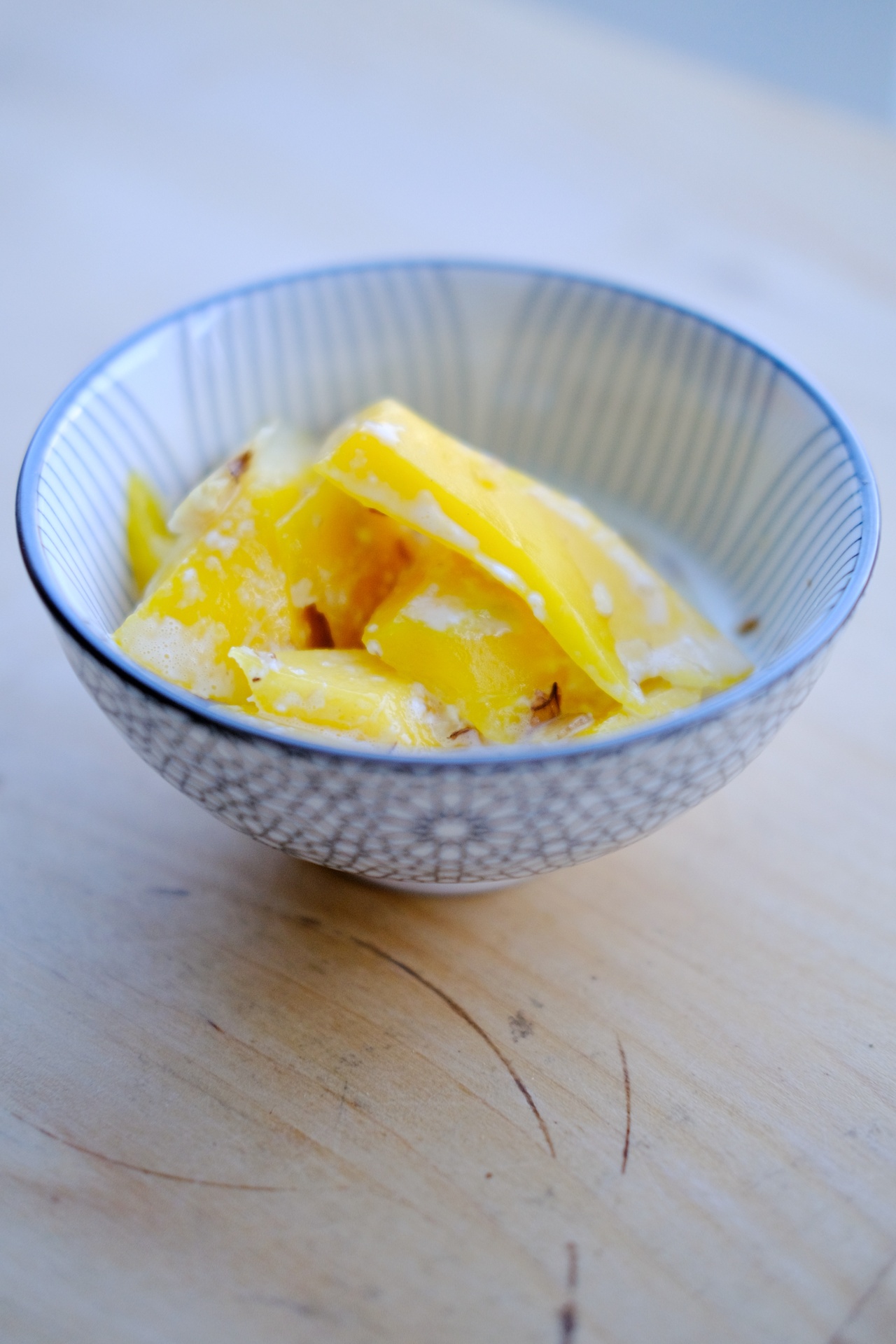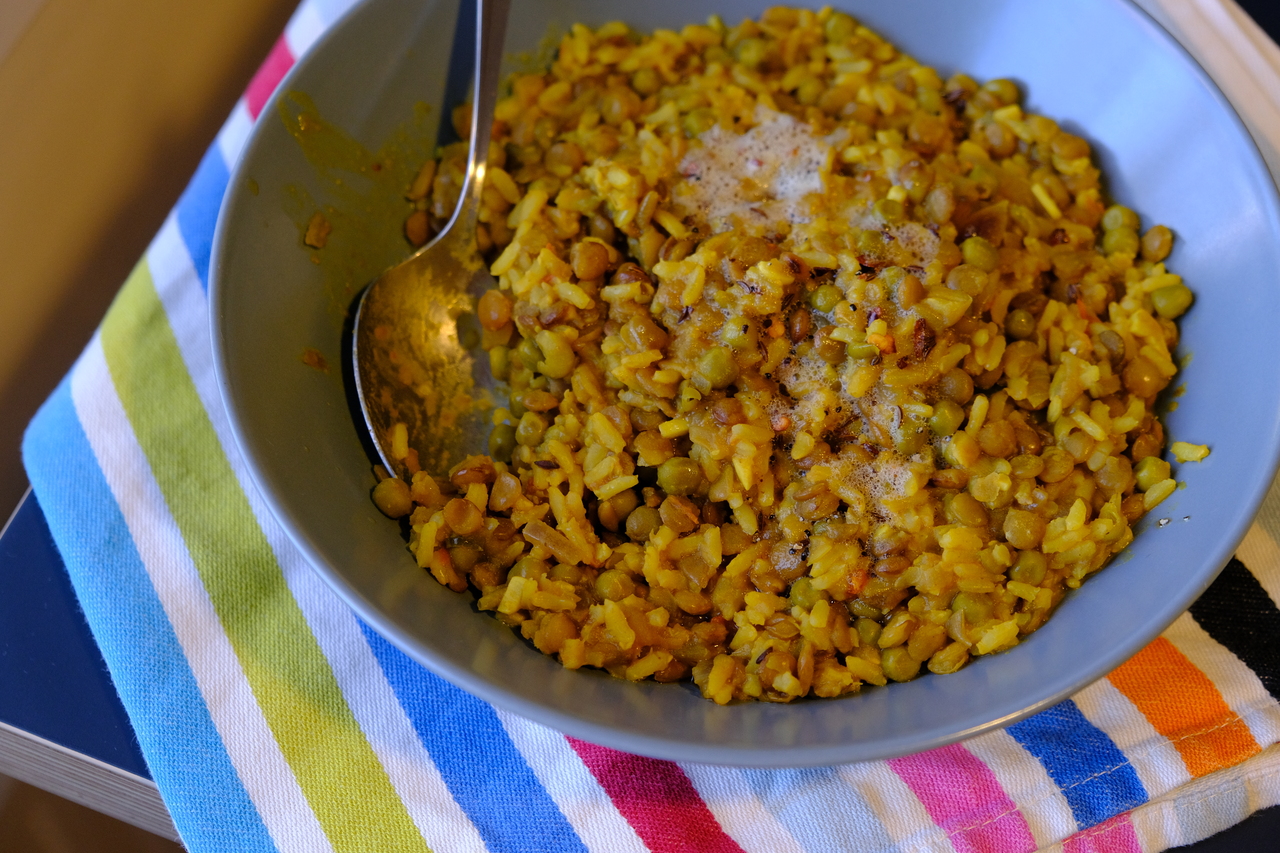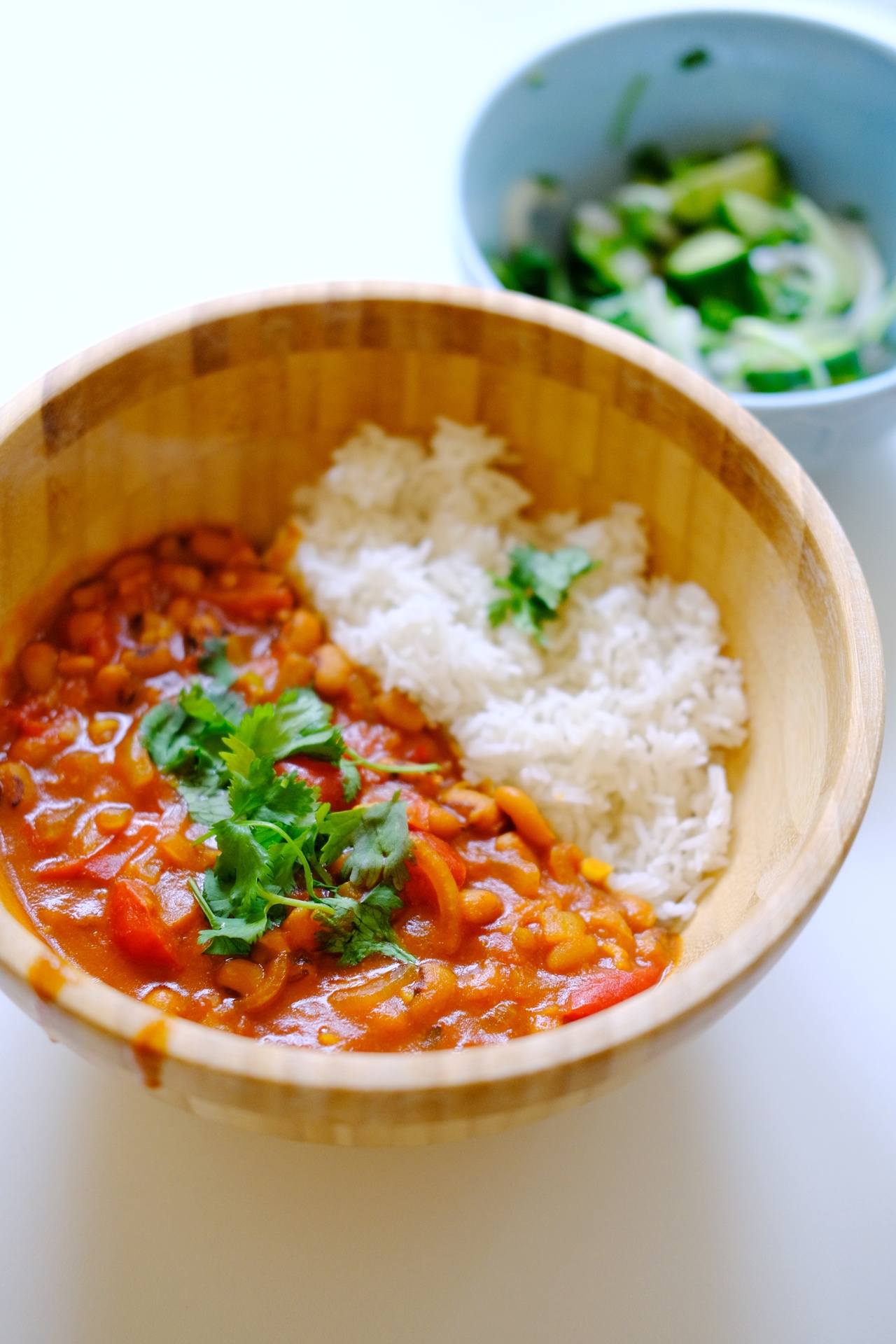An amazing book on Indian cuisine, as recommended by Mark Bittman, is Classic Indian Cooking by Julie Sahni, from 1980. Another nice source of inspiration is this restaurant owner.
Some breads (there are way more though):
- Chapati unleavened flatbread baked on a griddle
- Naan leavened, tandoor- or oven-baked flatbread
- Is apparently more "restaurant" like, in contrast to
- Paratha unleavened flatbread, really popular every-day bread
Other dishes I want to make:
- Vada pav deep fried potato dumpling in a bun
- Chenna poda sweet dessert from fresh cheese
- Kali dal buttered black beans; rich and special dish
Safaid channe and palak raita

Simple legumes with yogurt salad and rice in my mother's kitchen, Tilburg, 2021.
I was reading through Classic Indian Cooking by Julie Sahni and found lots of interesting legume and vegetable dishes. Peculiarly, Julie spells it as channe, while it currently seems to be much more commonly spelled as chana; when referring to chickpea dishes. Anyway, safaid means that we have a chickpea dish in a fragrant, light, ginger sauce.
- Chickpeas
- Onions
- Garlic
- Ginger
- Ground coriander
- Ground cardamom
- Lemon juice
- Ground pepper corns
- Chopped tomato
Fry the onion in a good quantity of oil over medium-high. Then we add our aromatics; garlic and ginger, frying for a few more minutes. Throw in our spices: coriander, cardamom, pepper and toast for a moment. Add the tomato and simmer until the oil begins to separate. Pour in reserved chickpea liquid and our lemon juice, together with some water and salt. Cover and simmer until we get a consistency of a pulpy gravy, then add the chickpeas themselves, and continue simmering. Transfer to a serving bowl and garnish with onion slices and chilies.
Julie recommends this to be served with poori, which is a fried flat bread. I plan on making this another time, but now I served it with rice (preferably basmati).
I made palak raita (spinach and yogurt salad) on the side, to balance out the safaid channe.
Tear off the hard stems of your spinach: fold them in half along the stem and then pull it out. Lightly blanch the spinach in properly salted water at a rolling boil. Get them out and push as much liquid out of them as possible, before coarsely chopping them. Mix yogurt and sour cream (3:1), cumin, coriander, and black pepper in a bowl and thoroughly refrigerate them. When ready to serve, stir the spinach and salt through the seasoned yogurt; sprinkle with additional cumin and coriander for garnish.
Malai aam

Mangoes in cream from Julie Sahni, served as dessert to the meal for my parents detailed above, Tilburg, 2021.
A light and refreshing dessert from mangoes and rabadi (a thickened milk sauce). Cut up some mangos into large pieces, sprinkle with chopped walnutes, cover, and chill thoroughly. Put the rabadi and some sugar in a blender until it is reduced to a smooth sauce. Transfer to a bowl, cover, and chill. Serve the mango slices and pass the rabadi sauce on the side.
So, how do I actually make the rabadi?
Bring milk to a boil in a heavy pan, stirring constantly (careful attention is crucial; we don't want the milk to stick to the bottom). Lower the heat and simmer the milk for forty-five to sixty minutes. Stir very frequently, scraping down the sides and preventing the formation of a skin on top (because that hinders evaporation). We are looking for a reduction to roughly thirty-three percent of the original quantity of milk. Cool for a few minutes, transfer to a bowl and refrigerate. While cooling, it will reduce the quantity to about twenty-five percent.
Chapati

My first try at chapati in my mother's kitchen, Tilburg, 2021.
Indian breads! My heart is delighted every time I think about them. Chapati is a very common staple, especially in Northern India (Southern parts are apparently more into rice). It is also known as roti, but I believe that might be a more generic term for breads.
Chapati is an unleavened flatbread made from whole-wheat flour. The whole-wheat flour is known as atta and is actually a bit different from the one I can buy in Western supermarkets. In Indian atta, the entire wheat kernel is ground to a fine powder, while our whole-wheat flour is much coarser in texture. People often also sift the atta flour to pick out the remaining bran flakes (outer layer of the kernel). Using this flour then delivers a silky smooth texture that offers little resistance.
Julie Sahni has two recommendations when you cannot find atta flour. Either, sift whole-wheat flour and throw away all the bran flakes (this quantity might be shocking). Or, mix the whole-wheat flour with all-purpose flour (2:1). The latter is what I opted for.
Julie Sahni is very adamant on the uniquely Indian preparation of the dough. The distinguishing factor is the importance of water: its addition to the dough must be very precise, and kneading is done with water instead of flour. There are three steps in the preparation: mixing, kneading, and resting.
- Place flour in a bowl, and pour in the water in a stream (fast at first) while mixing it in with your other hand to moisten it so that it gathers into a mass. Always irk on the low side of adding water. Only if the dough feels a bit too dry, add a little more.
- The Indian method of kneading is also unique. Firstly, prepare a small bowl filled with some water and put it near your working space. Form a fist and dip your knuckles into the water. Knead the dough by pressing your knuckles into it repeatedly, as though punching it. (I can't deny that at some points I got a bit carried away and actually started punching my dough.) Simultaneously, push and spread away the dough. Lift one edge of the dough and fold it back over itself. Continue this kneading ritual for about ten to fifteen minutes, while dipping your knuckles in water from time to time. We are looking for a very soft and pliable dough, that springs back when you quickly push your finger into it.
- Resting relaxes the dough such that it becomes less resistant to stretching and rolling. Julie notes that the temperature in Indian kitchens — ranging between 38 and 48 ℃ — is ideal for the dough, because it allows it to ferment slightly, thereby causing it to rise. This makes the dough light, airy, and spongy (as though it leavened slightly). To mimic this in my non-tropical kitchen, I put the dough in an oven with only the lights turned on. Cover the bowl with a moist towel or sheet of plastic wrap. Rest for at least half an hour.
Cut the dough into small rounds, roughly pat them flat and cover both sides in a light coating of flour to prevent it from sticking to your work bench or rolling pin. Do this one-by-one. Roll the patty into a thin round circle by actually rolling the rolling pin in a brisk back-and-forth motion. We are not Europeans (making tarts, pies, or quiches) who only spread out a dough in a single direction (away or toward oneself); it does not properly stretch the dough.
Gently place the bread on a hot griddle or pan until the first side is cooked and has several brown spots. Flip, and bake the other side.
Stack up the breads folded into kitchen paper or thick napkins. This keeps the bread warm and prevents the bottom ones from becoming moist as they stack up and the steam cannot escape anymore.
Serve chapati with anything you like.
Knowing all this, chapati is nothing more than flour and water (3:1). You can add a little bit of salt to taste, but in general, you're going to eat it with dishes that are rich in taste already, so there might not actually be a need to.
Khichdi

Northern Indian khichdi in my room in Helsinki, 2021.
Indian cuisines are deliciously plenty and complex to break into. So many different regions, people, ingredients, etc. Khichdi seems to be a popular dish in many regions, although mostly in the northern part of the country. For inspiration I read through Wikipedia and found a popular recipe on YouTube.
- Heat some oil and infuse with cumin seeds (and asafoetida, if you have some).
- Garlic, ginger => in.
- Onion
- Chopped fresh tomatoes and green chilies
- After a few minutes I also added some green peas
- Add more spices; turmeric, chili, garam masala
- Add and fry your rice and lentils (1:1)
- Cover with water and simmer with lid on for a while
For serving, we top the khichdi with a tadka; tempered spices. The fat of the oil carries the spices beautifully. I tempered some chili flakes, cumin seeds, and cardemom.
Spinach dal
- Onions, garlic, coriander seeds, chili
- Tomato, cumin, turmeric, salt
- Water
- Lentils
- Spinach
- Serve with basmati rice
Punjabi lobia

Punjabi style black-eyed peas curry in spicy onion and tomato gravy, in my room in Amsterdam, 2021.
A hearty black-eyed peas curry from the Punjab region on the Indian subcontinent. I first stumbled on a recipe by Sam Jones from The Guardian that piqued my interest for a quick weeknight meal. Then I naturally looked for an authentic source. It's satisfying to recognize the different types of Indian breads that get recommended to eat alongside this curry (chapati, paratha, roti), after I recently did some research into them using Julie Sahni's Classic Indian Cooking.
Anyway, I fried garlic, ginger, and a few hot chilies in butter on medium-high heat until it took the raw edge off. Sprinkled in a healthy dose of powders: turmeric, coriander, cumin. Stir for a minute. Add in onion, layer over some salt to draw out moisture more quickly, and simmer for five minutes. I then poured in some tomato passata, sliced up cherry tomatoes, and a spoon of mango chutney. Simmer for a while (maybe until you see some fat separated from the tomato sauce). I threw in a tin of black-eyed peas, including their liquid (be mindful of whether yours is salted or not; if it is, I suggest rinsing the beans first and throwing in fresh water with them instead, got to be in control of your salts). Continue simmering, lightly mashing some beans according to personal preference.
I served it in my new wooden bowl with basmati rice and fresh cilantro, and a quickly pickled cucumber-onion salad on the side.